Barb
Barbus Barbus
Barbs change colors during breeding season.
Advertisement
Barb Scientific Classification
- Kingdom
- Animalia
- Phylum
- Chordata
- Class
- Actinopterygii
- Order
- Cypriniformes
- Family
- Cyprinidae
- Genus
- Barbus
- Scientific Name
- Barbus Barbus
Read our Complete Guide to Classification of Animals.
Barb Conservation Status
Barb Facts
- Prey
- Small fish, algae, insects
- Main Prey
- Fish, Shrimp, Algae
- Group Behavior
- School
- Fun Fact
- Barbs change colors during breeding season.
- Estimated Population Size
- unknown
- Biggest Threat
- water pollution
- Most Distinctive Feature
- vibrant colors
- Distinctive Feature
- Easily adaptable and rows of teeth
- Gestation Period
- 3-4 days
- Optimum pH Level
- 6.0 - 8.0
- Habitat
- Slow flowing rivers and lagoons
- Predators
- Fish, Birds, Reptiles
- Diet
- Omnivore
- Favorite Food
- Fish
- Type
- Cypriniformes
- Common Name
- Barb
- Number Of Species
- 1768
- Average Clutch Size
- 1500
- Slogan
- There are over 1768 known species!
Barbs are freshwater fish belonging to a family of 1,184 species. They are popular aquarium fish because of their brilliant colors of gold, orange, rosy, silver, and cherry, along with others. Also, they are available for an inexpensive price at pet shops. Though small in size, they’re aggressive predators of fish, crustaceans, and insects.
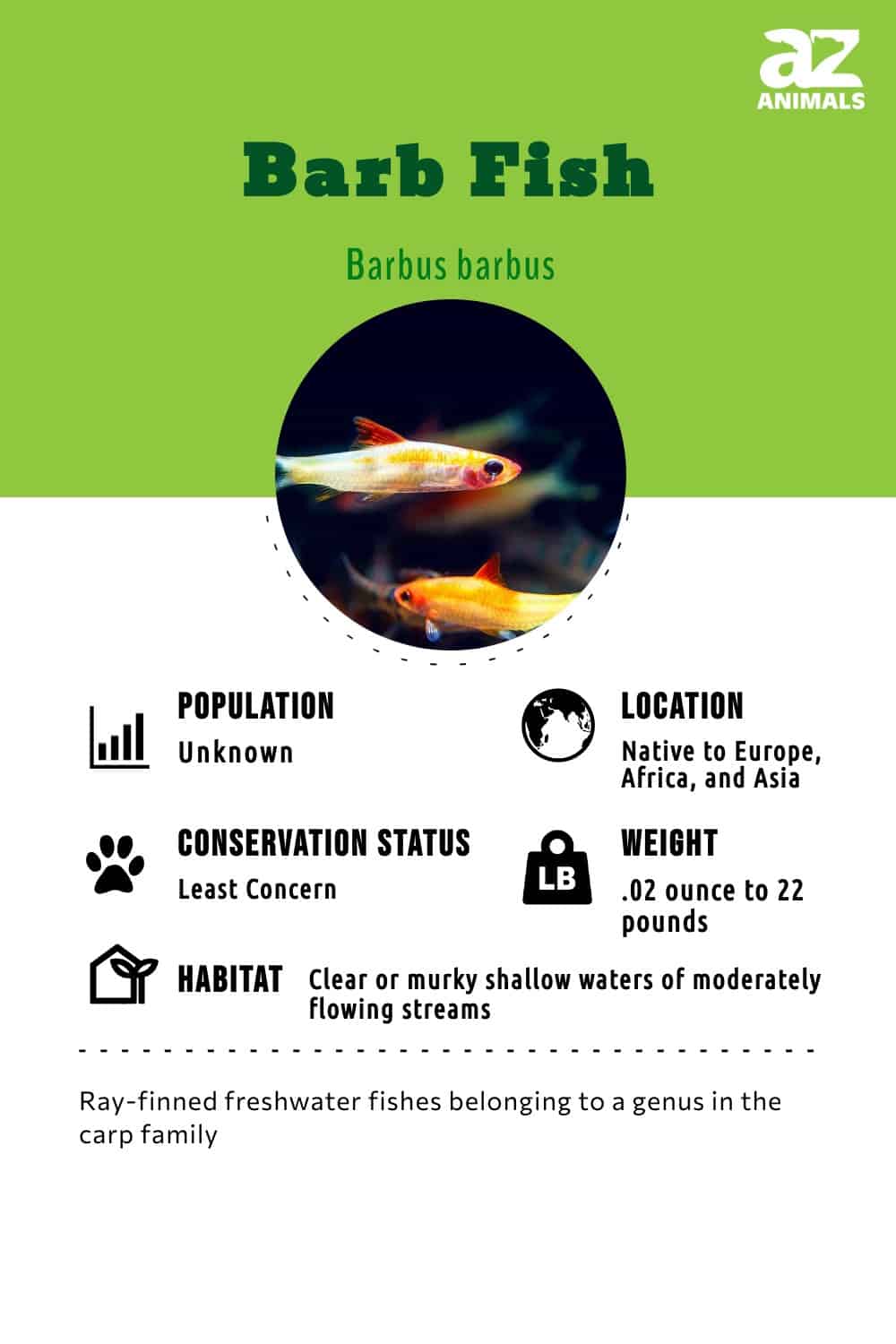
3 Barb Facts
• Breeding colors: The rosy barb is notable for changing colors during the breeding season to attract mates. Male rosy barbs change from silver to a combination of gold and red. It’s rare for a female rosy barb’s yellow and pink scales to change, but the color does become more intense.
• Tough fish: Barb fish have an aggressive nature. They’re likely to eat smaller types of fish. This is why aquarium owners should only pair barbs with other barbs or larger types of fish.
• High adaptability: These fish have the rare quality of being able to adapt to changes in their habitat. This includes changes in water temperature and pH level.
Classification and Scientific Name
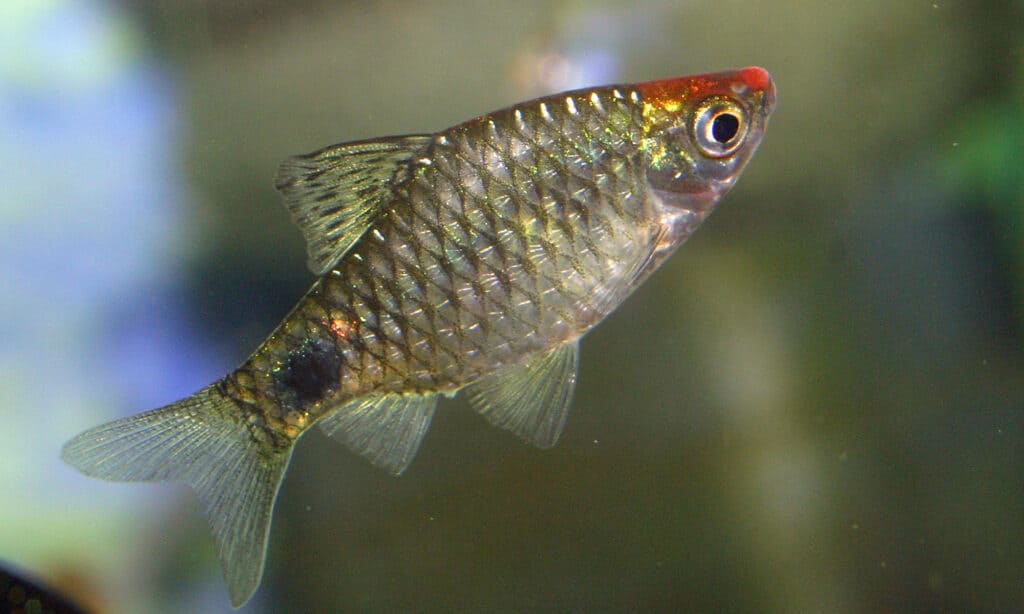
Barbs are freshwater fish belonging to a family of 1,768 species.
©VladiMil/Shutterstock.com
The scientific name of the barb fish is Barbus barbus. The Latin word Barbus translates to beard. The word beard refers to the barbels or bristle structures on barb fish. Look very closely at the Zebra barb and the Denison barb, and you’ll find tiny barbels located near their mouth. These are used to sense and locate prey.
They are in the Cyprinidae family and the class Actinopterygii.
Just a few of the 1,184 species of barb fish:
• Barbodes dunckeri
• Puntius titteya
• Sahyadria denosonii
Types of Barb Fish: The Different Species
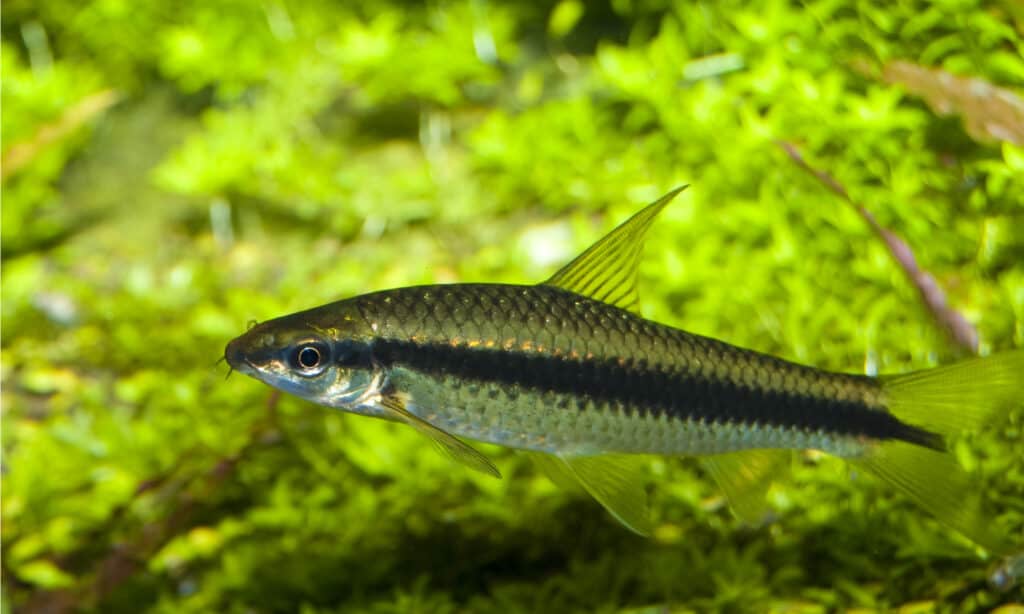
Barbs are popular pets — perfect for aquarium life.
©iliuta goean/Shutterstock.com
The Cyprinidae family contains hundreds of species that vary in size and color. This is what makes them so popular with people looking to add dynamic fish to a freshwater aquarium without paying a high price.
Some of the most notable and colorful examples of the barb family include:
• Cherry barb: These fish live in the Kelani basin near Sri Lanka. Normally, they have brown or tan scales with red and orange tones. But, during the breeding season, males turn a brilliant cherry red.
• Tiger barb: It’s named for both its color and behavior. It has silver scales featuring black stripes with orange highlights on its fins and mouth. Not only does it have a color pattern like a tiger, but this fish is also known to nip at the delicate fins of other fish!
• Gold barb: The gold barb is also called a Chinese barb because it’s from the Red River basin in China. This three-inch fish adds a flash of orange or gold scales to its aquarium habitat. Gold barbs are one of the common types sold in pet stores.
• Rosy barb: These fish are native to the northern part of India. Rosy barbs have glowing red scales and a forked tail. They’re a little bigger than most barbs at six inches.
Appearance
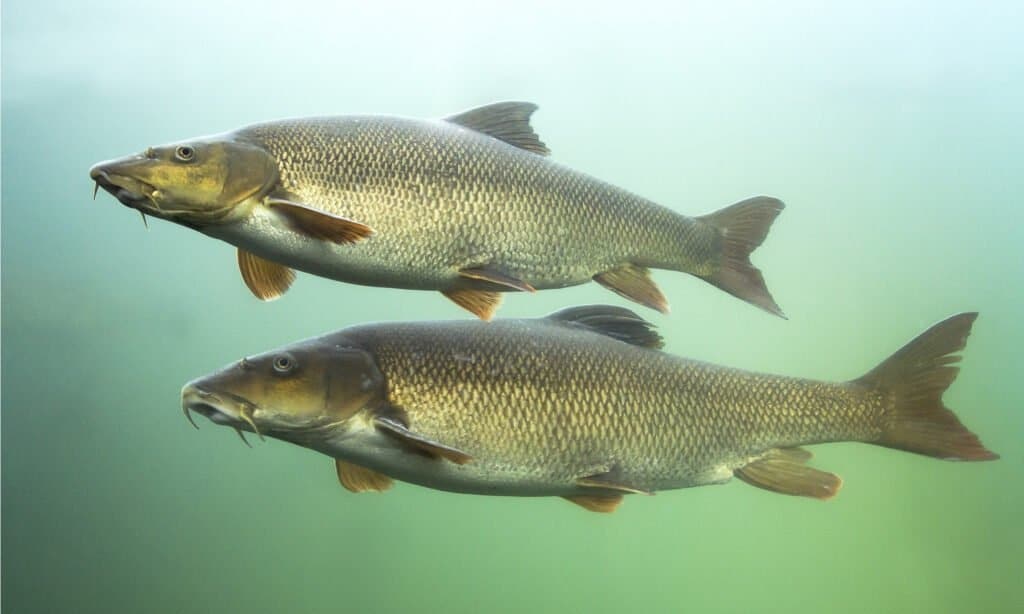
Barbs are aggressive, but they’re also hearty and adaptable.
©Rostislav Stefanek/Shutterstock.com
The different types of barbs can be orange, red, black, gold, striped, or even rosy. Some barbs are as small as two and a half inches, like the black ruby barb, while other types can measure 12 inches long. The longest is the Tinfoil barb at 13.7 inches. Alternatively, some of the most popular barbs, like the gold barb and the Tiger barb, are three inches in size.
These small fish have tiny barbels or bristles near their mouth. Barbels are used in the wild to find prey in murky water.
Barbs have an aggressive nature. Along with eating algae, they are excellent hunters. They go after smaller fish, worms, and crustaceans.
It’s important for an aquarium owner to avoid putting smaller fish in the same tank as barbs. They are likely to eat the smaller fish!
Birds and larger fish are predators of barb fish. Not surprisingly, it’s difficult for a brightly colored barb to blend in with its environment to escape. So, these animals rely on their quick swimming abilities to get away from threats. Also, barbs live in schools allowing most of them to escape when they encounter a predator.
Distribution, Population, and Habitat
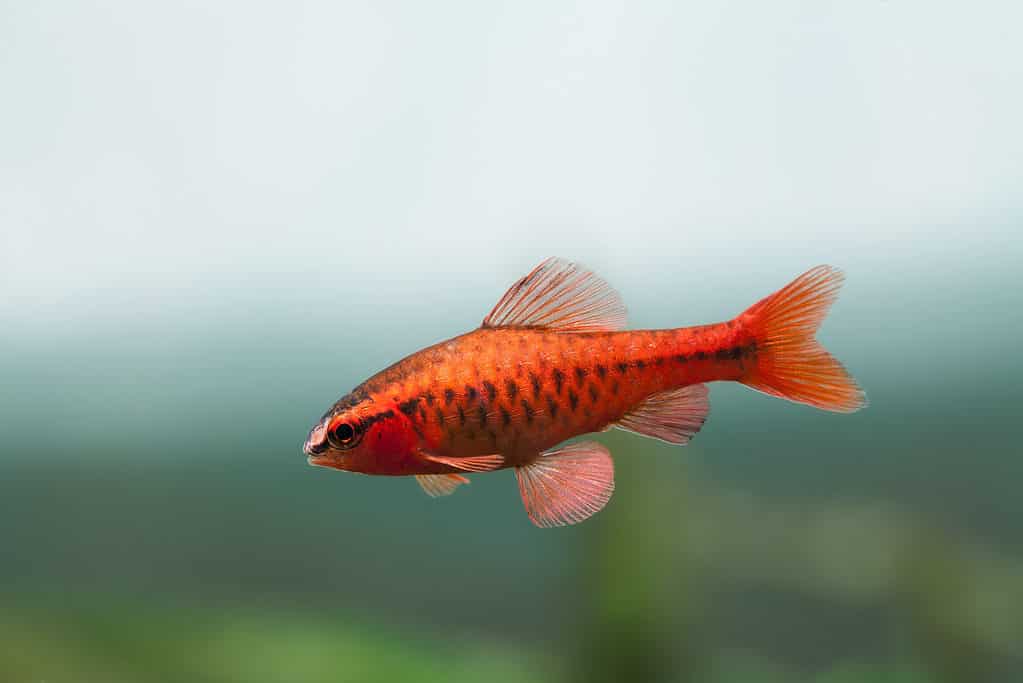
Barb fish come from many different regions, such as China and Taiwan.
©Besjunior/Shutterstock.com
Barbs are freshwater fish. Different types of barbs are from different regions. For instance, the gold barb is native to rivers and streams around China, Vietnam, and Taiwan. Rosy barbs live in lakes and streams around India. Tiger barbs are found in Borneo and Malaysia.
These fish can live in bodies of water three to 16 feet in depth.
The IUCN Red List reports the barb fish as Least Concern, but with an unknown population. There are no conservation efforts in place for these fish.
Predators and Prey
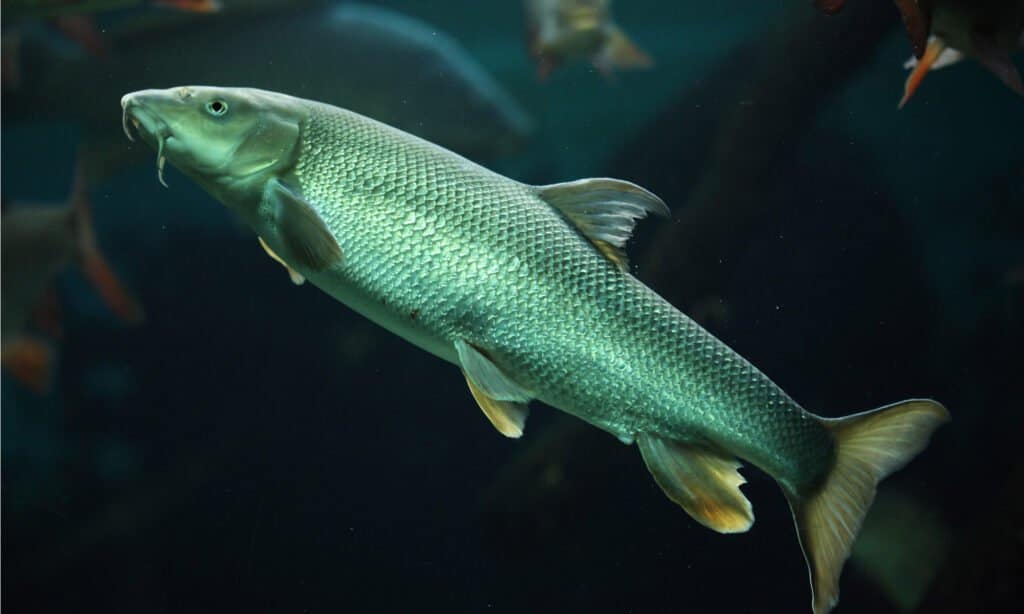
Barbs eat algae, smaller fish, insects, and crustaceans.
©Vladimir Wrangel/Shutterstock.com
Barbs are omnivorous. They are notable for eating a variety of both plants and animals in their habitat.
What eats barb fish?
In the wild, barbs are eaten by larger fish, reptiles, and birds such as seagulls. They are also captured by humans for breeding and sale to aquarium enthusiasts.
Despite these threats, they are listed as the Least Concern.
What does a barb fish eat?
They eat algae, smaller fish, insects, and crustaceans. They are aggressive hunters and may go after larger fish, but that’s rare. Usually, their prey is smaller.
Reproduction and Lifespan
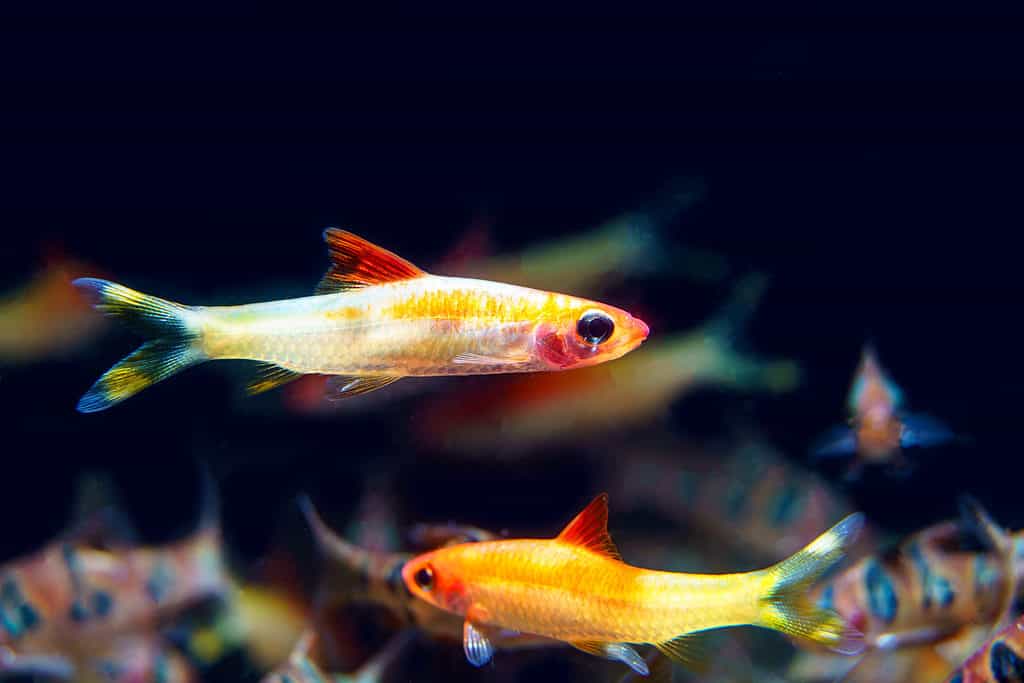
Depending on their skin and lighting conditions, a glisten of gold tones may appear on the Denison barb’s scales.
©chonlasub woravichan/Shutterstock.com
Barbs reach sexual maturity at six weeks old. In the spring, when the water is warm, a female barb releases 200 to 300 eggs into the water at one time. A male barb releases sperm and fertilizes the eggs. The eggs hatch in two to three days.
Someone breeding barbs should know these fish are likely to eat the eggs. So, it’s a good idea to put the male and female into another aquarium right away.
Fishing and Cooking
Barbs are too small to eat. Their colorful patterns and inexpensive price have made them popular with fish enthusiasts of all experience levels.
They are hardy fish living up to five years.
1184 Types of Barb Fish
| Barbus Species |
|---|
| Barbus ablabes |
| Barbus ablabes spurelli |
| Barbus aboinensis |
| Barbus acuticeps |
| Barbus acutirostris |
| Barbus aeneus |
| Barbus afer |
| Barbus affinis |
| Barbus affinis affinis |
| Barbus affinis brevibarbis |
| Barbus affinis nedgia |
| Barbus afrohamiltoni |
| Barbus afrovernaya |
| Barbus afrovernayi |
| Barbus ahlselli |
| Barbus akakianus |
| Barbus akavangoensis |
| Barbus akeleyi |
| Barbus albanicus |
| Barbus alberti |
| Barbus aliciae |
| Barbus alloiopleurus |
| Barbus alluaudi |
| Barbus aloyi |
| Barbus altianalis |
| Barbus altianalis altianalis |
| Barbus altianalis eduardianus |
| Barbus altianalis labiosa |
| Barbus altianalis lobogenysoides |
| Barbus altianalis longifilis |
| Barbus altianalis paucisquamata |
| Barbus altianalis radcliffi |
| Barbus altianalis radcliffii |
| Barbus altianalis urundensis |
| Barbus altianalis var. lobogenysoides |
| Barbus altianalis var. paucisquamata |
| Barbus altianalis var. paucisquamatus |
| Barbus alticola |
| Barbus altidorsalis |
| Barbus altus |
| Barbus alvarezi |
| Barbus amanpoae |
| Barbus amatolicus |
| Barbus ambassis |
| Barbus amboseli |
| Barbus amguidensis |
| Barbus ampalong |
| Barbus amphibius |
| Barbus amphigramma |
| Barbus analis |
| Barbus anatolicus |
| Barbus anchisporus |
| Barbus andrewi |
| Barbus anema |
| Barbus angustatus |
| Barbus annamensis |
| Barbus annandalei |
| Barbus annectens |
| Barbus anniae |
| Barbus anoplus |
| Barbus anoplus anoplus |
| Barbus anoplus cernuus |
| Barbus anoplus oraniensis |
| Barbus anoplus typica |
| Barbus ansorgii |
| Barbus antinorii |
| Barbus aphantogramma |
| Barbus aphya |
| Barbus apleurogramma |
| Barbus apoensis |
| Barbus apogon |
| Barbus apogonostomatus |
| Barbus arabicus |
| Barbus arambourgi |
| Barbus arcislongae |
| Barbus arenatus |
| Barbus argenteus |
| Barbus argyrotaenia |
| Barbus armatus |
| Barbus armenicus |
| Barbus arulius |
| Barbus ashmeadi |
| Barbus asoka |
| Barbus asper |
| Barbus aspilus |
| Barbus aspius |
| Barbus atakorensis |
| Barbus athi |
| Barbus atkinsoni |
| Barbus atlanticus |
| Barbus atromaculatus |
| Barbus aurantiacus |
| Barbus aureus |
| Barbus aurotaeniatus |
| Barbus auxartiacus |
| Barbus babaulti |
| Barbus bagbwensis |
| Barbus balcanicus |
| Barbus balleroides |
| Barbus bampurensis |
| Barbus banguelensis |
| Barbus bangwelensis |
| Barbus bantamensis |
| Barbus bantolanensis |
| Barbus barbulus |
| Barbus barbus |
| Barbus barbus barbus |
| Barbus barbus bergi |
| Barbus barbus bocagei |
| Barbus barbus borysthenicus |
| Barbus barbus gallicus |
| Barbus barbus macedonicus |
| Barbus barbus plebejus |
| Barbus barbus sclateri |
| Barbus barbus thessalus |
| Barbus barilioides |
| Barbus barnardi |
| Barbus barotseensis |
| Barbus barroisi |
| Barbus barryi |
| Barbus baschakirdi |
| Barbus batesi |
| Barbus batesii |
| Barbus baudoni |
| Barbus baudoni baudoni |
| Barbus baudoni ubangensis |
| Barbus baudoni ubanguensis |
| Barbus bawkuensis |
| Barbus bayoni |
| Barbus beasleyi |
| Barbus beavani |
| Barbus beddomi |
| Barbus beddomii |
| Barbus belayewi |
| Barbus bellcrossi |
| Barbus bergi |
| Barbus bernardcarpi |
| Barbus beso |
| Barbus bifrenatus |
| Barbus bigornei |
| Barbus biharicus |
| Barbus bilkewitschi |
| Barbus binduchitra |
| Barbus bingeri |
| Barbus binny |
| Barbus binotatus |
| Barbus biscarensis |
| Barbus biscarensis amguidensis |
| Barbus biscariensis |
| Barbus blanci |
| Barbus blitonensis |
| Barbus blythii |
| Barbus boboi |
| Barbus bocagei |
| Barbus bocagei sclateri |
| Barbus bomokandi |
| Barbus bonvaloti |
| Barbus bortschalinicus |
| Barbus borysthenicus |
| Barbus bottegi |
| Barbus boulengerii |
| Barbus bourdariei |
| Barbus bourdarieri |
| Barbus bovanicus |
| Barbus bowkeri |
| Barbus brachycephalus |
| Barbus brachycephalus brachycephalus |
| Barbus brachycephalus caspius |
| Barbus brachygramma |
| Barbus brachynemus |
| Barbus bramoides |
| Barbus brazzae |
| Barbus brazzai |
| Barbus breijeri |
| Barbus brevibarbis |
| Barbus brevicephalus |
| Barbus breviceps |
| Barbus brevidorsalis |
| Barbus brevifilis |
| Barbus brevilateralis |
| Barbus brevipennis |
| Barbus brevipinnis |
| Barbus brevis |
| Barbus brevispinis |
| Barbus brevispinis monunensis |
| Barbus brevispinnis |
| Barbus brichardi |
| Barbus brookingi |
| Barbus brucii |
| Barbus brucii gunningi |
| Barbus brunellii |
| Barbus brunellii acutirostris |
| Barbus brunellii brunellii |
| Barbus bulu |
| Barbus burchelli |
| Barbus burgi |
| Barbus burmanicus |
| Barbus bynni |
| Barbus bynni bynni |
| Barbus bynni occidentalis |
| Barbus bynni rudolfianus |
| Barbus bynni waldroni |
| Barbus cadenati |
| Barbus caldwelli |
| Barbus calidus |
| Barbus callensis |
| Barbus callensis figuigensis |
| Barbus callewaerti |
| Barbus callipterus |
| Barbus camptacanthus |
| Barbus camptacanthus camptacanthus |
| Barbus camptacanthus liberiensis |
| Barbus camptacanthus melanepiptera |
| Barbus canalii |
| Barbus candens |
| Barbus caninus |
| Barbus canis |
| Barbus capensis |
| Barbus capito |
| Barbus capito capito |
| Barbus capito conocephalus |
| Barbus capito massaensis |
| Barbus capito pectoralis |
| Barbus carcharhinoides |
| Barbus cardozoi |
| Barbus carens |
| Barbus carletoni |
| Barbus carnaticus |
| Barbus carottae |
| Barbus carpathicus |
| Barbus carpenteri |
| Barbus carpio |
| Barbus castrasibutum |
| Barbus cataractae |
| Barbus catenarius |
| Barbus caucasicus |
| Barbus caudimacula |
| Barbus caudimarginatus |
| Barbus caudosignatus |
| Barbus caudovittatus |
| Barbus cauveriensis |
| Barbus cercops |
| Barbus cernuus |
| Barbus chagunio |
| Barbus chantrei |
| Barbus cheilynoides |
| Barbus chelynoides |
| Barbus chicapaensis |
| Barbus chilinoides |
| Barbus chilotes |
| Barbus chilotes sakaniae |
| Barbus chiumbeensis |
| Barbus chlorotaenia |
| Barbus chola |
| Barbus choloensis |
| Barbus chondrorhynchus |
| Barbus chonglingchungi |
| Barbus chrysopoma |
| Barbus chrysopterus |
| Barbus ciscaucasicus |
| Barbus citrinus |
| Barbus claudinae |
| Barbus clauseni |
| Barbus clavatus |
| Barbus clavatus bartoni |
| Barbus clavatus burtoni |
| Barbus codringtoni |
| Barbus codringtonii |
| Barbus cogginii |
| Barbus colemani |
| Barbus collarti |
| Barbus collingwoodii |
| Barbus comiza |
| Barbus comiza nasus |
| Barbus comizo |
| Barbus communis |
| Barbus communis |
| Barbus communis cyclolepis |
| Barbus compinei |
| Barbus compiniei |
| Barbus compressiformis |
| Barbus compressus |
| Barbus conchonius |
| Barbus conchonlus |
| Barbus condei |
| Barbus congicus |
| Barbus conirostris |
| Barbus conocephalus |
| Barbus cookei |
| Barbus cookii |
| Barbus cosuatis |
| Barbus crassibarbis |
| Barbus crocodilensis |
| Barbus cumingi |
| Barbus cumingii |
| Barbus cummungi |
| Barbus curmuca |
| Barbus curtus |
| Barbus cyclolepis |
| Barbus cyclolepis cholorematicus |
| Barbus cyclolepis cyri |
| Barbus cyclolepis strumicae |
| Barbus cyclolepis waleckii |
| Barbus cyri |
| Barbus cyri var. chaldanica |
| Barbus cyri var. chaldanicus |
| Barbus dageti |
| Barbus dainellii |
| Barbus dainellii macrocephalus |
| Barbus dartevellei |
| Barbus daruphani |
| Barbus deauratus |
| Barbus decioi |
| Barbus decipiens |
| Barbus degeni |
| Barbus degeni leptorhinus |
| Barbus deguidei |
| Barbus deliciosus |
| Barbus dendrotrachelus |
| Barbus denisoni |
| Barbus denisonii |
| Barbus deserti |
| Barbus devosi |
| Barbus dezwaani |
| Barbus dialonensis |
| Barbus diamouanganai |
| Barbus diliciosus |
| Barbus diplocheilus |
| Barbus diplochilus |
| Barbus ditinensis |
| Barbus dobsoni |
| Barbus doggetti |
| Barbus dolichosoma |
| Barbus donaldsonsmithi |
| Barbus donyensis |
| Barbus dorsalis |
| Barbus dorsimaculatus |
| Barbus dorsolineatus |
| Barbus douronensis |
| Barbus dubius |
| Barbus duchesnii |
| Barbus duchesnii ibridus |
| Barbus duchesnii leptorhinus |
| Barbus duchesnii maximus |
| Barbus dukai |
| Barbus dunckeri |
| Barbus duvancelli |
| Barbus duvancellii |
| Barbus duvaucelii |
| Barbus dwaarsensis |
| Barbus eburneensis |
| Barbus eduardianus |
| Barbus elephantis |
| Barbus elongatus |
| Barbus enoploides |
| Barbus enoplos |
| Barbus enoplus |
| Barbus ensis |
| Barbus entaenia |
| Barbus eques |
| Barbus eques |
| Barbus ercisianus |
| Barbus erlangeri |
| Barbus erubescens |
| Barbus erythrozonus |
| Barbus escherichii |
| Barbus esocinus |
| Barbus ethiopicus |
| Barbus euboicus |
| Barbus euboicus sperchiensis |
| Barbus euchilus |
| Barbus eugrammus |
| Barbus eumystus |
| Barbus euphrati |
| Barbus eurystomus |
| Barbus eutaenia |
| Barbus evansi |
| Barbus everetti |
| Barbus exulatus |
| Barbus faciolatus |
| Barbus fairbairnii |
| Barbus faoensis |
| Barbus fasciatus |
| Barbus fasciolatus |
| Barbus fasolt |
| Barbus fergussonii |
| Barbus figuiensis |
| Barbus figuigensis |
| Barbus figuiguensis |
| Barbus filamentosa |
| Barbus filamentosus |
| Barbus fitzsimonsi |
| Barbus flomoi |
| Barbus fluviatilis |
| Barbus fluviatilis alba |
| Barbus fluviatilis aurata |
| Barbus fluviatilis borysthenicus |
| Barbus fluviatilis tyberinus |
| Barbus fluviatilis tyrasensis |
| Barbus foerschi |
| Barbus foureaui |
| Barbus foutensis |
| Barbus foxi |
| Barbus francisci |
| Barbus fraseri |
| Barbus fritschii |
| Barbus fritschii fritschii |
| Barbus fritschii harteti |
| Barbus fucini |
| Barbus gambiensis |
| Barbus gananensis |
| Barbus gardonides |
| Barbus gelius |
| Barbus gerlachi |
| Barbus gestetneri |
| Barbus gibbosus |
| Barbus gilchristi |
| Barbus girardi |
| Barbus globiceps |
| Barbus gobioides |
| Barbus goktschaicus |
| Barbus gonionotus |
| Barbus goniosoma |
| Barbus gorgorensis |
| Barbus gorguari |
| Barbus gorguarii macrophtalmus |
| Barbus gourmansis |
| Barbus graceus |
| Barbus gracilis |
| Barbus graecus |
| Barbus graecus prespensis |
| Barbus graellsii |
| Barbus graelsii |
| Barbus grahami |
| Barbus greenwoodi |
| Barbus gregorii |
| Barbus gribinguensis |
| Barbus grouti |
| Barbus gruveli |
| Barbus grypus |
| Barbus gudaricus |
| Barbus guentheri |
| Barbus guganio |
| Barbus guildi |
| Barbus guineensis |
| Barbus guirali |
| Barbus guirali melanepiptera |
| Barbus guiraonis |
| Barbus gulielmi |
| Barbus gunningi |
| Barbus gurneyi |
| Barbus guttatus |
| Barbus haaseanus |
| Barbus haasi |
| Barbus haasianus |
| Barbus habereri |
| Barbus hainani |
| Barbus halei |
| Barbus hamiltoni |
| Barbus hampal |
| Barbus hampal bimaculata |
| Barbus hampaloides |
| Barbus harringtonii |
| Barbus harterti |
| Barbus harteti |
| Barbus helleri |
| Barbus hemipleurogramma |
| Barbus hemispinus |
| Barbus hemispinus cincta |
| Barbus hemispinus cinctus |
| Barbus herrei |
| Barbus heteronema |
| Barbus hexagonolepis |
| Barbus hexagonolepsis |
| Barbus hexastichus |
| Barbus hexazona |
| Barbus hindii |
| Barbus hindii mawambiensis |
| Barbus hoevenii |
| Barbus holasi |
| Barbus hollyi |
| Barbus holotaenia |
| Barbus holubi |
| Barbus homozonus |
| Barbus hondeensis |
| Barbus hosii |
| Barbus hospes |
| Barbus huangchuchieni |
| Barbus huguenini |
| Barbus huguenyi |
| Barbus huloti |
| Barbus hulstaerti |
| Barbus humeralis |
| Barbus humilis |
| Barbus humphri |
| Barbus hursensis |
| Barbus hypostomatus |
| Barbus hypsolepis |
| Barbus ilgi |
| Barbus inaequalis |
| Barbus incomoides |
| Barbus inermis |
| Barbus inermoides |
| Barbus innocens |
| Barbus innominatus |
| Barbus intermedius |
| Barbus intermedius |
| Barbus intermedius australis |
| Barbus intermedius brevicauda |
| Barbus intermedius eurystomus |
| Barbus intermedius gorgorensis |
| Barbus intermedius intermedius |
| Barbus intermedius latirostris |
| Barbus intermedius leptosoma |
| Barbus intermedius microstoma |
| Barbus issenensis |
| Barbus iturii |
| Barbus ivis |
| Barbus ivongoensis |
| Barbus jacksoni |
| Barbus jacksonii |
| Barbus jacksonii mitior |
| Barbus jacobusboehlkei |
| Barbus jae |
| Barbus janssensi |
| Barbus janthochir |
| Barbus jarsinus |
| Barbus javanicus |
| Barbus jerdoni |
| Barbus jerdoni maciveri |
| Barbus jerdoni muciveri |
| Barbus johnstonii |
| Barbus jubbi |
| Barbus kahajani |
| Barbus kakus |
| Barbus kalopterus |
| Barbus kamaia |
| Barbus kamaiae |
| Barbus kamolondoensis |
| Barbus karkensis |
| Barbus karoualensis |
| Barbus karunensis |
| Barbus kassamensis |
| Barbus katangae |
| Barbus kemoensis |
| Barbus kersin |
| Barbus kerstenii |
| Barbus kerstenii kerstenii |
| Barbus kerstenii luhondo |
| Barbus kessleri |
| Barbus khudree |
| Barbus khudree malabaricus |
| Barbus kimberleyensis |
| Barbus kiogae |
| Barbus kiperegensis |
| Barbus kissiensis |
| Barbus kivuensis |
| Barbus kniluensis |
| Barbus koilometopon |
| Barbus kolus |
| Barbus kosswigi |
| Barbus krapfi |
| Barbus krempfi |
| Barbus kreyenbergii |
| Barbus ksibi |
| Barbus kubanicus |
| Barbus kuiluensis |
| Barbus kurumani |
| Barbus kusanensis |
| Barbus labeo |
| Barbus labialis |
| Barbus labiatomimus |
| Barbus labiatus |
| Barbus labiosa |
| Barbus lacerta |
| Barbus lacerta cyri |
| Barbus lacerta escherichii |
| Barbus lacertoides |
| Barbus laevis |
| Barbus lagensis |
| Barbus lagoensis |
| Barbus lamani |
| Barbus lancrenonensis |
| Barbus laoensis |
| Barbus lapsus |
| Barbus lateristriga |
| Barbus laticeps |
| Barbus lauzannei |
| Barbus lawak |
| Barbus lawrae |
| Barbus layardi |
| Barbus lefukiensis |
| Barbus leonensis |
| Barbus leonhardi |
| Barbus lepidotus |
| Barbus lepidura |
| Barbus lepidus |
| Barbus lepineyi |
| Barbus leptopagon |
| Barbus leptopogon |
| Barbus leptosoma |
| Barbus lestradei |
| Barbus liberiensis |
| Barbus limbata |
| Barbus lineamaculatus |
| Barbus lineatus |
| Barbus lineolatus |
| Barbus lineomaculatus |
| Barbus lineomaculatus lineomaculatus |
| Barbus lineomaculatus quadrilineatus |
| Barbus linnellii |
| Barbus lissochiloides |
| Barbus litamba |
| Barbus lithopidos |
| Barbus lobochilus |
| Barbus lobogenys |
| Barbus lobogenysoides |
| Barbus longicauda |
| Barbus longiceps |
| Barbus longifilis |
| Barbus longirostris |
| Barbus longirostrum |
| Barbus longispinis |
| Barbus longissimus |
| Barbus lorenzi |
| Barbus lornae |
| Barbus lorteti |
| Barbus loveridgii |
| Barbus luapulae |
| Barbus luazomela |
| Barbus lucius |
| Barbus lufukiensis |
| Barbus luhondo |
| Barbus luikae |
| Barbus lujae |
| Barbus lukindae |
| Barbus lukusiensis |
| Barbus luluae |
| Barbus lumiensis |
| Barbus luteus |
| Barbus lydianus |
| Barbus macedonicus |
| Barbus machadoi |
| Barbus macinensis |
| Barbus macmillani |
| Barbus macracanthus |
| Barbus macrocephalus |
| Barbus macroceps |
| Barbus macrolepidotus |
| Barbus macrolepis |
| Barbus macronema |
| Barbus macronema parenzani |
| Barbus macrophtalmus |
| Barbus macropristis |
| Barbus macropristis meruensis |
| Barbus macrops |
| Barbus macrotaenia |
| Barbus macrurus |
| Barbus maculatus |
| Barbus maculatus |
| Barbus maculatus hagenii |
| Barbus magdalenae |
| Barbus magniatlantis |
| Barbus mahakkamensis |
| Barbus malabaricus |
| Barbus malacanthus |
| Barbus mandarinus |
| Barbus manguaoensis |
| Barbus manicensis |
| Barbus marequensis |
| Barbus margarianus |
| Barbus margaritae |
| Barbus marginatus |
| Barbus mariae |
| Barbus marleyi |
| Barbus marmoratus |
| Barbus martorelli |
| Barbus massaensis |
| Barbus massaensis labiosa |
| Barbus massaensis labiosus |
| Barbus massaensis massaensis |
| Barbus mathoiae |
| Barbus matris |
| Barbus matsudai |
| Barbus matthesi |
| Barbus mattozi |
| Barbus mawambi |
| Barbus mawambiensis |
| Barbus mayori |
| Barbus mbami |
| Barbus mediosquamatus |
| Barbus megalepis |
| Barbus megastoma |
| Barbus melanampyx |
| Barbus melanepiptera |
| Barbus melanhypopterus |
| Barbus melanopterus |
| Barbus melanostigma |
| Barbus melanotaenia |
| Barbus meneliki |
| Barbus mentalis |
| Barbus mento |
| Barbus meridionalis |
| Barbus meridionalis meridionalis |
| Barbus meridionalis petenyi |
| Barbus meridionalis rebeli |
| Barbus meruensis |
| Barbus mfongosi |
| Barbus microbarbis |
| Barbus microcephalus |
| Barbus microlepis |
| Barbus micronema |
| Barbus microphthalmus |
| Barbus micropogon |
| Barbus micropogon mysorensis |
| Barbus micropogon periyarensis |
| Barbus microps |
| Barbus microterolepis |
| Barbus milesi |
| Barbus miliaris |
| Barbus mimus |
| Barbus minchinii |
| Barbus miochilus |
| Barbus miolepis |
| Barbus miolepis miolepis |
| Barbus miolepis rubrostigma |
| Barbus mirabilis |
| Barbus mirabilus |
| Barbus mirei |
| Barbus mocoensis |
| Barbus moeruensis |
| Barbus mohasicus |
| Barbus mohasicus mohasicus |
| Barbus mohasicus paucisquamata |
| Barbus mosal |
| Barbus motebensis |
| Barbus motebensis kamaiae |
| Barbus motebensis motebensis |
| Barbus mottozi |
| Barbus moulouyensis |
| Barbus moulouyensis bouramensis |
| Barbus moulouyensis grandisquamata |
| Barbus moulouyensis moulouyensis |
| Barbus multilineatus |
| Barbus multimaculatus |
| Barbus mungoensis |
| Barbus mursa |
| Barbus mursoides |
| Barbus mussullah |
| Barbus musullah |
| Barbus musumbi |
| Barbus myersi |
| Barbus myitkyinae |
| Barbus mylodon |
| Barbus mysorensis |
| Barbus mystaceus |
| Barbus nairobi |
| Barbus nairobiensis |
| Barbus nanningsi |
| Barbus narayani |
| Barbus nashii |
| Barbus nasus |
| Barbus nasutus |
| Barbus natalensis |
| Barbus nedgia |
| Barbus neefi |
| Barbus neglectus |
| Barbus neilli |
| Barbus neumayeri |
| Barbus neuvillei |
| Barbus neuvillii |
| Barbus nicholsi |
| Barbus nigeriensis |
| Barbus nigrifilis |
| Barbus nigriparipinnis |
| Barbus nigrodorsalis |
| Barbus nigrofasciatus |
| Barbus nigrolinea |
| Barbus nigroluteus |
| Barbus nigrovittatus |
| Barbus niluferensis |
| Barbus niokoloensis |
| Barbus njassae |
| Barbus normani |
| Barbus nounensis |
| Barbus nummifer |
| Barbus nyanzae |
| Barbus nyassae |
| Barbus oatesi |
| Barbus oatesii |
| Barbus obesus |
| Barbus obtusirostris |
| Barbus occidentalis |
| Barbus occidentalis foureaui |
| Barbus okae |
| Barbus okavangoensis |
| Barbus oligogrammus |
| Barbus oligolepis |
| Barbus oliogolepis |
| Barbus olivaceus |
| Barbus ophicephalus |
| Barbus oreas |
| Barbus oresigenes |
| Barbus orphoides |
| Barbus osseensis |
| Barbus owenae |
| Barbus oxycephalus |
| Barbus oxyrhynchus |
| Barbus pagenstacheri |
| Barbus pagenstecheri |
| Barbus pahangensis |
| Barbus palavanensis |
| Barbus pallaryi |
| Barbus pallidus |
| Barbus paludinosis |
| Barbus paludinosus |
| Barbus paludonosus |
| Barbus palustris |
| Barbus papilio |
| Barbus pappenheimi |
| Barbus parabablabes |
| Barbus parablabes |
| Barbus paradoxus |
| Barbus paradoxus quinquefasciatus |
| Barbus parajae |
| Barbus parallens |
| Barbus parawaldroni |
| Barbus parieschanica |
| Barbus parrah |
| Barbus partipentazona |
| Barbus paucisquamatus |
| Barbus paytonii |
| Barbus pectoralis |
| Barbus pellegrini |
| Barbus peloponnesius |
| Barbus pentazona |
| Barbus pentazona pentazona |
| Barbus pentazona schwanefeldi |
| Barbus percival kitalensis |
| Barbus percivali |
| Barbus percivali percivali |
| Barbus pergamonensis |
| Barbus perince |
| Barbus pernice |
| Barbus perniciosus |
| Barbus perplexicans |
| Barbus perplexicans mbami |
| Barbus perplexicans perplexicans |
| Barbus pessuliferus |
| Barbus petchkovskyi |
| Barbus petenyi |
| Barbus petenyii |
| Barbus petitjeani |
| Barbus pfefferi |
| Barbus phlegethon |
| Barbus phlegetun |
| Barbus phutunio |
| Barbus pienaarii |
| Barbus pienaarti |
| Barbus pierrei |
| Barbus pietschmanni |
| Barbus pietschmanni hollyi |
| Barbus pietschmanni pietschmanni |
| Barbus pingi |
| Barbus pinnauratus |
| Barbus plagiostomus |
| Barbus platydorsus |
| Barbus platyrhinus |
| Barbus platysoma |
| Barbus platystomus |
| Barbus platystomus daga |
| Barbus platystomus dekkensis |
| Barbus platystomus platystomus |
| Barbus platystomus prognathus |
| Barbus platystomus vatovae |
| Barbus plebeius |
| Barbus plebeius |
| Barbus plebejus |
| Barbus plebejus ercisianus |
| Barbus plebejus euboicus |
| Barbus plebejus kosswigi |
| Barbus plebejus pergamonensis |
| Barbus plebejus plebejus |
| Barbus plebejus tauricus |
| Barbus pleurogramma |
| Barbus pleuropholis |
| Barbus pleurotaenia |
| Barbus pobeguini |
| Barbus pobeguini mauritanica |
| Barbus pobeguini pobeguini |
| Barbus podonemus |
| Barbus poechii |
| Barbus poehli |
| Barbus pojeri |
| Barbus polydori |
| Barbus polylepis |
| Barbus polyspilos |
| Barbus portali |
| Barbus potamogalis |
| Barbus prespensis |
| Barbus prionacanthus |
| Barbus procatopus |
| Barbus proctozysron |
| Barbus proctozystron |
| Barbus profundus |
| Barbus progeneius |
| Barbus progenys |
| Barbus pseudognathodon |
| Barbus pseudognathus |
| Barbus pseudotoppini |
| Barbus puckelli |
| Barbus puellus |
| Barbus pulchellus |
| Barbus pumilis |
| Barbus pumilus |
| Barbus punctatus |
| Barbus punctitaeniatus |
| Barbus punjabensis |
| Barbus punjaubensis |
| Barbus puntio |
| Barbus putitora |
| Barbus pygmaeus |
| Barbus pyrhopterus |
| Barbus quadralineatus |
| Barbus quadrilineatus |
| Barbus quadrimaculatus |
| Barbus quadripunctatus |
| Barbus quinquemaculatus |
| Barbus radcliffi |
| Barbus radcliffii |
| Barbus radiatus |
| Barbus radiatus aurantiacus |
| Barbus radiatus barotseensis |
| Barbus radiatus profundus |
| Barbus radiatus radiatus |
| Barbus raimbaulti |
| Barbus rapax |
| Barbus rebeli |
| Barbus regani |
| Barbus reinii |
| Barbus rendahli |
| Barbus repasson |
| Barbus rhinoceros |
| Barbus rhinophorus |
| Barbus rhoadesii |
| Barbus rhodesianus |
| Barbus rhomboocellatus |
| Barbus riggenbachi |
| Barbus robinsoni |
| Barbus rocadasi |
| Barbus rogersi |
| Barbus rohani |
| Barbus rosae |
| Barbus roseipinnis |
| Barbus rothschildi |
| Barbus roulei |
| Barbus roussellei |
| Barbus rouxi |
| Barbus roylii |
| Barbus ruandae |
| Barbus ruasae |
| Barbus rubellus |
| Barbus rubripinnis |
| Barbus rubripinnis |
| Barbus rubrostigma |
| Barbus rudolfianus |
| Barbus rueppellii |
| Barbus ruspolii |
| Barbus ruspolii brevispinis |
| Barbus ruspolii ruspolii |
| Barbus sabiensis |
| Barbus sachsi |
| Barbus sachsii |
| Barbus sacratus |
| Barbus salessei |
| Barbus salmo |
| Barbus samniticus |
| Barbus samniticus |
| Barbus sarana |
| Barbus sarana caudimarginatus |
| Barbus sarananella |
| Barbus saranella |
| Barbus sauvagei |
| Barbus schanicus |
| Barbus scheemanni |
| Barbus schlegelii |
| Barbus schneemanni |
| Barbus schoutedeni |
| Barbus schwanefeldi |
| Barbus schwanefeldii |
| Barbus schwanenfeldi |
| Barbus schwanenfeldii |
| Barbus scincus |
| Barbus sclateri |
| Barbus sealei |
| Barbus sector |
| Barbus seeberi |
| Barbus seguensis |
| Barbus semibarbus |
| Barbus semifasciolatus |
| Barbus sensitivus |
| Barbus senticeps |
| Barbus serengetiensis |
| Barbus serra |
| Barbus serrifer |
| Barbus serrula |
| Barbus setifensis |
| Barbus setigerus |
| Barbus setivimensis |
| Barbus setivimensis labiosa |
| Barbus setivimensis setivimensis |
| Barbus sewelli |
| Barbus sexradiatus |
| Barbus seymouri |
| Barbus shacra |
| Barbus shanensis |
| Barbus sharpeyi |
| Barbus simus |
| Barbus sinensis |
| Barbus sinensis denticulatus |
| Barbus singhala |
| Barbus somereni |
| Barbus somerini |
| Barbus somphongsi |
| Barbus sophore |
| Barbus sophore stigma |
| Barbus sophoroides |
| Barbus soro |
| Barbus soroides |
| Barbus speleops |
| Barbus sperchiensis |
| Barbus spilopholus |
| Barbus spilopterus |
| Barbus spilurus |
| Barbus spinulosus |
| Barbus spurelli |
| Barbus spurrelli |
| Barbus squamosissimus |
| Barbus srilankensis |
| Barbus stanleyi |
| Barbus stappersii |
| Barbus stauchi |
| Barbus steindachneri |
| Barbus stevensonii |
| Barbus stigma |
| Barbus stigmasemion |
| Barbus stigmaticus |
| Barbus stigmatopygus |
| Barbus stigmatosomus |
| Barbus stoliczkanus |
| Barbus stracheyi |
| Barbus strigatus |
| Barbus strumicae |
| Barbus subinensis |
| Barbus sublimus |
| Barbus sublineatus |
| Barbus subnasutus |
| Barbus subquincunciatus |
| Barbus surkis |
| Barbus sursunicus |
| Barbus susanae |
| Barbus svenssoni |
| Barbus swierstrae |
| Barbus sylvaticus |
| Barbus syntrechalepis |
| Barbus szechwanensis |
| Barbus taeniopleura |
| Barbus taeniurus |
| Barbus taitensis |
| Barbus tambra |
| Barbus tambroides |
| Barbus tanapelagius |
| Barbus tanensis |
| Barbus tangandensis |
| Barbus tauricus |
| Barbus tauricus escherichii |
| Barbus tauricus kubanicus |
| Barbus tauricus oligolepis |
| Barbus tauricus rionica |
| Barbus tauricus tauricus |
| Barbus tegulifer |
| Barbus tenuis |
| Barbus terio |
| Barbus tetrarupagus |
| Barbus tetraspilus |
| Barbus tetraspilus |
| Barbus tetrastigma |
| Barbus tetrazona |
| Barbus tetrazona johorensis |
| Barbus tetrazona partipentazona |
| Barbus tetrazona tetrazona |
| Barbus teugelsi |
| Barbus thamalakanensis |
| Barbus thamalakenensis |
| Barbus thermalis |
| Barbus thessalus |
| Barbus thikensis |
| Barbus thomassi |
| Barbus thysi |
| Barbus ticto |
| Barbus ticto stoliczkae |
| Barbus tiekoroi |
| Barbus titius |
| Barbus titteya |
| Barbus tomiensis |
| Barbus tongaensis |
| Barbus tonkinensis |
| Barbus toppini |
| Barbus tor |
| Barbus trachypterus |
| Barbus traorei |
| Barbus treurensis |
| Barbus trevelyani |
| Barbus trimaculatus |
| Barbus trinotatus |
| Barbus trispiloides |
| Barbus trispilomimus |
| Barbus trispilopleura |
| Barbus trispilopleura arcislongae |
| Barbus trispilos |
| Barbus trispilos quinquepunctata |
| Barbus trispilous |
| Barbus trispilus quinquepunctata |
| Barbus tropidolepis |
| Barbus truncatus |
| Barbus truttiformis |
| Barbus tsanensis |
| Barbus tshopoensis |
| Barbus tsotsorogensis |
| Barbus tugelensis |
| Barbus turkanae |
| Barbus tyberinus |
| Barbus uellensis |
| Barbus umbeluziensis |
| Barbus unimaculatus |
| Barbus unitaeniatus |
| Barbus urmianus |
| Barbus urostigma |
| Barbus urostigma |
| Barbus urotaenia |
| Barbus urundensis |
| Barbus usambarae |
| Barbus valenciennesii |
| Barbus validus |
| Barbus vanderysti |
| Barbus venustus |
| Barbus vernayi |
| Barbus versluysii |
| Barbus victoriae |
| Barbus viktorianus |
| Barbus vinciguerrai |
| Barbus vittatus |
| Barbus viviparus |
| Barbus volpinii |
| Barbus voltae |
| Barbus vulgaris |
| Barbus vulneratus |
| Barbus waageni |
| Barbus waandersi |
| Barbus waldoi |
| Barbus waldroni |
| Barbus waleckii |
| Barbus walkeri |
| Barbus weidholzii |
| Barbus wellmani |
| Barbus welwitschii |
| Barbus wenchowensis |
| Barbus werneri |
| Barbus wurtzi |
| Barbus wynaadenis |
| Barbus wynaadensis |
| Barbus xanthopterus |
| Barbus xanthos |
| Barbus yeiensis |
| Barbus yongei |
| Barbus yunnanensis |
| Barbus zalbiensis |
| Barbus zambezensis |
| Barbus zanzibaricus |
| Barbus zaphiri |
| Barbus zelleri |
| Barbus zonatus |
| Barbus zuaicus |
| Barbus zuluensis |
Barb FAQs (Frequently Asked Questions)
Where are barbs found?
These are freshwater fish living in streams, lakes and rivers around Europe, southeast Asia, and Africa.
Are barbs aggressive fish?
Yes, they are known to be aggressive.
Are barbs good fish?
Yes. They are fun to watch and admire!
What barb fish are peaceful?
The tinfoil barb is one exception and is known to have a more peaceful nature than other barbs. However, any barb fish can become aggressive toward smaller fish.
Are barb fish hardy?
Yes, they are hardy and adaptable to their environment.
Why are they called barb fish?
The name barb translates to beard. This relates to the tiny barbels located near a barb’s mouth.
How big do barb fish get?
Some types of barbs only grow to three inches long while others, like the tinfoil barb, can be as long as 13.7 inches!
How to say Barb in ...
Thank you for reading! Have some feedback for us? Contact the AZ Animals editorial team.
Sources
- , Available here: https://ourmarinespecies.com/c-fishes/barb-fish-characteristics-habitats-types-and-more/
- , Available here: https://en.wikipedia.org/wiki/Clown_barb
- , Available here: https://www.iucnredlist.org/species/2561/97789324
- , Available here: https://www.learnaboutnature.com/animals/fish/cherry-barb/
- , Available here: https://theaquariumadviser.com/barb-fish/
- , Available here: https://www.thesprucepets.com/barb-species-1380768
- , Available here: https://helpusfish.com/1/24/are-barb-fish-aggressive.html

















